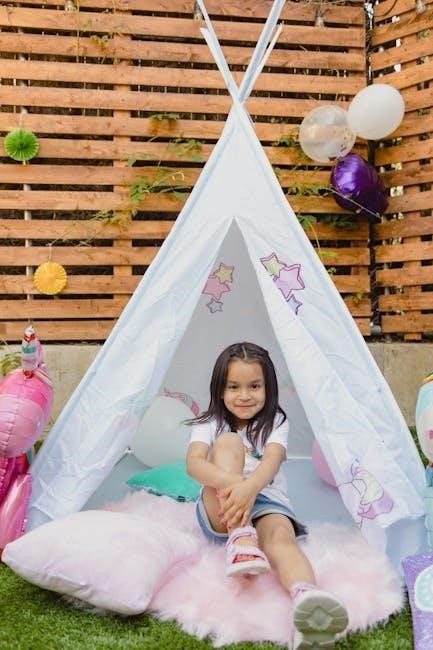Setting up a party tent can be straightforward with the right guidance. This guide offers comprehensive instructions and practical advice for a safe, stable, and successful event setup.
1.1 Importance of Proper Tent Setup for Events
Proper tent setup is crucial for ensuring safety, stability, and a successful event. A well-secured tent protects guests from weather conditions and prevents structural damage. Incorrect assembly can lead to accidents or equipment failure, risking both safety and event reputation. Following detailed instructions guarantees a sturdy and reliable shelter, creating a comfortable environment for attendees. This guide emphasizes the necessity of precise setup to avoid common pitfalls and ensure a seamless experience for all participants.
1.2 Brief Overview of Party Tent Types
Party tents come in various styles to suit different needs. Frame tents are sturdy, customizable, and ideal for weddings. Pole tents offer a classic look with a peaked roof, perfect for large gatherings. Pop-up canopies are lightweight and portable, great for small events. Inflatable tents provide a modern aesthetic with quick setup. Each type offers unique benefits, ensuring there’s a tent to match any event size, theme, and terrain, making them versatile solutions for outdoor celebrations and professional setups alike.
Choosing the Right Party Tent Size and Type
Selecting the right tent involves considering guest count, available space, and event type. Choose frame tents for weddings or pop-up canopies for casual gatherings.
2.1 How to Select the Correct Tent Size for Your Event
Selecting the correct tent size ensures comfort and functionality. Calculate guest count, add space for tables, chairs, and aisles. Consider the tent’s peak height for an open feel. Measure the setup area to ensure proper fit. For events with dining, allow 10-12 square feet per person. For gatherings with seating, add extra space. Larger tents like 10×30 or 20×40 are ideal for big events. Ensure the tent fits your venue and meets local regulations.
2.2 Popular Party Tent Types: Frame Tents vs. Pole Tents
Frame tents and pole tents are the most common types. Frame tents are versatile, easy to set up, and ideal for hard surfaces. They offer a sleek design and are perfect for events requiring a modern look. Pole tents are traditional, often used for backyard gatherings, and are more budget-friendly. They require stakes and open space, making them less suitable for paved areas. Choose based on your event’s size, location, and style for the best results. Both offer durability and weather resistance, ensuring a stable setup.
Essential Tools and Equipment Needed
3.1 Must-Have Tools for Tent Assembly
Essential tools include a hammer, screwdriver, measuring tape, ropes, and safety gear like gloves and goggles for a secure and efficient setup.
Essential tools for tent assembly include a hammer, screwdriver, measuring tape, and sturdy ropes. Safety gear like gloves and goggles is crucial. A toolkit with wrenches and Allen keys will help secure frames. Ensure all parts are organized to avoid delays. Optional items like a ladder or pressure wrench may be needed for larger tents. Proper tools ensure a smooth and efficient setup process, minimizing risks and ensuring stability for your event.
3.2 Recommended Safety Equipment
Ensure safety by using gloves, goggles, and sturdy footwear during assembly. A first-aid kit is essential for minor injuries. Use rope tie-downs and sandbags to secure the tent firmly. Weather monitors and emergency stakes are crucial for stability. Always inspect the tent for damage before setup. Proper safety equipment helps prevent accidents and ensures a secure environment for your event, protecting both people and the tent structure from potential hazards.

Preparing the Setup Site
Select a flat, dry spot, avoiding overhead obstacles. Clear debris and level the ground. Ensure the area is safe and ready for tent assembly.
4.1 How to Choose the Best Location for Your Tent
Choose a flat, dry area for your tent to ensure stability and safety. Avoid spots with overhead obstacles like trees or power lines. Ensure the location is close to power and water sources if needed. Check for proper drainage to prevent water accumulation. Consider wind direction to minimize impact. Ensure the site is accessible for guests and easy to navigate. Finally, verify local regulations or permits required for tent setup in your chosen location.
4.2 Clearing and Leveling the Ground
Clear the area of debris, rocks, and branches to ensure a smooth setup. Use a rake or shovel to level the ground, removing any uneven patches. Check for firmness to prevent the tent from sinking or shifting. Ensure the site is dry and free from puddles to avoid water damage. Properly clearing and leveling the ground ensures stability, safety, and a professional appearance for your event.

Step-by-Step Tent Assembly Instructions
Follow a systematic approach: unpack components, assemble the frame, attach the canopy, and secure the tent. This ensures a safe and efficient setup process.
5.1 Unpacking and Organizing Components
Begin by carefully unpacking the tent from its storage bag. Lay out all components, including poles, connectors, stakes, and the canopy, on a flat surface. Check the inventory list to ensure no parts are missing. Organize pieces by type or label to streamline assembly. Separate lightweight items like ropes and ties from heavier framework elements; This systematic approach prevents confusion and saves time during setup. Ensure all tools, such as wrenches or hammers, are readily accessible.
5;2 Assembling the Tent Framework
Start by attaching the tent poles to the base plates, ensuring they are securely connected. Align the frame according to the manufacturer’s instructions, typically beginning with the main structure. Attach side poles and connectors, making sure all joints are tight and properly aligned. Use the provided wrench or tool to tighten bolts firmly. Double-check that the framework stands upright and is evenly balanced. If necessary, consult the manual for specific configurations or additional support requirements.
5.3 Attaching the Canopy and Walls
Once the framework is assembled, carefully lay the canopy over the top, ensuring it aligns with the roof peaks. Secure it using the provided straps, Velcro, or hooks. Tighten evenly to avoid wrinkles. Next, attach the sidewalls by sliding their poles into the framework sockets or hooks. Fasten the walls securely with ropes, straps, or zippers. Ensure all seams and connections are tight to maintain structural integrity and weather resistance. Finally, check that all walls are evenly spaced and properly aligned with the canopy.
Securing the Tent
Securing your party tent is crucial for stability and safety. Use stakes, ropes, and weights to anchor the tent firmly to the ground, ensuring it withstands wind and weather conditions effectively.
6.1 Anchoring the Tent to the Ground
Anchoring your party tent securely to the ground is essential for stability. Use high-quality stakes and ropes, ensuring they are driven into firm soil at the correct angles. For added security, especially on hard surfaces, consider using weights or sandbags. Regularly inspect the anchors to ensure they remain tight and can withstand weather conditions like wind or rain. Proper anchoring prevents the tent from shifting or collapsing, ensuring a safe and enjoyable event.
6.2 Tightening the Canopy and Ensuring Stability
Tightening the canopy is crucial for maintaining the tent’s structural integrity. Ensure the fabric is taut by adjusting the framework and securing straps tightly. Check for any sagging or wrinkles, as these can lead to water pooling or damage. Use rope tie-offs to reinforce corners and sides, especially in windy conditions. Regularly inspect the canopy for loose connections and tighten as needed to ensure stability and prevent collapse during events.
Troubleshooting Common Issues
Identify and resolve common tent setup problems, such as loose parts or uneven surfaces. Tighten hardware, re-level the ground, and ensure all components are securely fastened for stability.
7.1 Dealing with Loose or Missing Parts
If parts are loose or missing, check the hardware kit and tighten any bolts or screws. Replace missing components with spares or purchase them separately. Ensure all connections are secure to maintain tent stability. Use a wrench or screwdriver to tighten any loose fittings. Double-check all parts before and after assembly to prevent issues during use. Properly securing all elements ensures safety and extends the tent’s lifespan.
7.2 Fixing Uneven or Sagging Rooflines
To fix an uneven or sagging roofline, inspect the frame for misalignment and tighten any loose connections. Adjust the roof beams to ensure they are evenly spaced and securely attached. If sagging occurs, check for excessive weight or improper assembly. Remove any accumulated snow or debris, as this can cause structural strain. Re-tighten all bolts and ensure the canopy is taut. Regular inspections and proper maintenance can prevent future issues and ensure the tent remains stable and secure.
Enhancing Tent Stability and Safety
Use weights and anchors for added security, ensure proper tension, and weather-proof the tent. Regular inspections and adjustments will maintain stability and safety throughout your event.
8.1 Using Weights and Anchors for Added Security
Secure your tent with heavy-duty weights or anchors to prevent shifting in wind. Place weights at each corner and ensure anchors are deeply driven into the ground. For soft surfaces, use long stakes, and on hard ground, consider screw anchors. Regularly inspect all securing points to maintain tightness. This ensures the tent remains stable, providing a safe environment for your event. Proper anchoring is essential for withstanding various weather conditions and keeping everyone safe.
8.2 Weather-Proofing Tips for Wind and Rain
Ensure your tent is weather-ready by sealing seams with waterproof tape and applying waterproofing sprays. Tighten the canopy to prevent water pooling and use reinforced ropes for added stability. Secure the tent with heavy-duty weights or sandbags on hard surfaces. Regularly inspect the tent for damage and clear debris from the area. For windy conditions, angle the tent to reduce wind resistance. These steps will help protect your event from unpredictable weather conditions and ensure a safe, dry environment for everyone.

Decorating and Customizing Your Party Tent
Transform your tent into a stylish space with creative lighting, themed decor, and flooring. Add vibrant colors, banners, or floral arrangements to match your event’s theme perfectly.
9.1 Lighting Ideas for a Vibrant Atmosphere
Lighting is a key element in creating a memorable event atmosphere. Use string lights, fairy lights, or LED uplighting to add warmth and ambiance. For outdoor gatherings, lanterns or solar-powered lights can enhance the setting. Consider color-changing LED lights for a modern touch. Place lights strategically to highlight the tent’s interior and exterior, ensuring even distribution. Dimmable options allow you to adjust the mood throughout the event. Add themed lighting, like fairy lights for weddings or neon for parties, to match your event’s style. Ensure safety by using weather-proof lights and avoiding overheating. Lighting transforms your tent into a vibrant, inviting space.
9.2 Adding Flooring and Interior Decor
Add flooring like vinyl, carpet, or interlocking tiles for comfort and aesthetics. Use drapes, fabric walls, or floral arrangements to create a polished look. Incorporate themed decor, such as fairy lights or centerpiece arrangements, to match your event’s style. Add tables, chairs, and decorative linens for functionality. Personalize the space with banners or balloons for celebrations. Ensure all elements are securely fastened to avoid damage. Proper flooring and decor transform your tent into a cozy, inviting atmosphere.
Customization enhances the event experience.

Maintenance and Storage
Properly clean and dry the tent before storage. Use mild detergents and avoid harsh chemicals. Store in a cool, dry place, checking for damage beforehand;
10.1 Cleaning the Tent After Use
Cleaning your party tent immediately after use is essential to maintain its quality. Use mild detergents and a soft-bristle brush to remove dirt and stains gently. Avoid harsh chemicals, as they may damage the fabric. Rinse thoroughly with clean water and allow the tent to air dry completely. Inspect for any mildew or stubborn stains and treat them promptly. Proper cleaning ensures the tent remains in good condition for future events and extends its lifespan.
10.2 Proper Storage to Extend Tent Lifespan
Proper storage is crucial for maintaining your party tent’s condition. After cleaning, ensure the tent is completely dry to prevent mildew. Store it in a sturdy storage bag, away from direct sunlight and moisture. Keep it in a cool, dry place, avoiding damp environments. Check for any damage before storage and repair it promptly. Regularly inspect stored tents to ensure they remain in good shape. Proper storage extends the tent’s lifespan and ensures it remains ready for future events.
Setting up a party tent is easily manageable with the right guidance. Choose the right tent, follow setup instructions, and ensure safety for your successful event.
11.1 Summary of Key Setup Steps
Choose a suitable location, clear the ground, and unpack components. Assemble the framework, attach the canopy and walls, and secure the tent with anchors. Tighten all connections for stability and ensure safety measures are in place. Proper setup ensures a stable and safe environment for your event, while following instructions carefully guarantees success. These steps are crucial for a secure and enjoyable gathering.
11.2 Final Tips for a Successful Event
Ensure all components are securely fastened and the tent is well-ventilated. Double-check weather forecasts and have a backup plan for unforeseen conditions. Pay attention to lighting and decorations to create a vibrant atmosphere. Assign someone to supervise the tent during the event. Keep emergency supplies on hand and ensure all exits are clear. Follow these tips to host a safe, memorable, and stress-free event for you and your guests.
